Nowadays, being an effective leader is more important than ever. To be successful, leaders need to think strategically, navigate complex problems, adapt to changes, and make sound decisions quickly. Subsequently, companies that invest in the growth and development of their leaders are more likely to dominate the ever-competitive market. That is particularly true of companies that deploy coaching solutions. But which business coaching methods are the most effective?
When a company employs an effective leadership coaching method, it sees improved employee engagement, higher productivity, better communication, and increased profitability. In the words of the world-renowned executive coach John Mattone: Effective leadership coaching methods empower leaders to identify their strengths and weaknesses, develop an improvement plan, and achieve their full potential as impactful and influential leaders.
So let us explore, one at a time, the seven most effective coaching methods ambitious companies should consider right now!
The GROW coaching method: structured goal achievement in executive coaching
The GROW model is one of the most widely used coaching methods for executives. It provides a clear structure for goal-oriented development discussions and supports coachees in recognizing realistic options for action and taking responsibility.
GROW helps individuals and teams to set and achieve goals through clarity, self-awareness, exploration of options, accountability and sustainability. The acronym stands for Goals, Reality, Options and Will (the four key elements of this coaching method). The method was developed by Alan Fine, Graham Alexander and Sir John Whitmore in the UK in the 1980s. GROW soon became very popular as an effective coaching method.

GROW is simple. It guides people through a structured conversation. The first step is to establish a clear goal or objective. The second step is to assess reality by looking at the current situation and identifying any obstacles or challenges. The third step is to explore the available options and brainstorm possible solutions. And finally, the fourth step is to commit to a plan of action and determine the next steps needed to achieve the goal. The GROW model finds its way into various settings beyond coaching sessions, such as mentoring and performance management.
🧭 Goal - Define goal
- Klärung des konkreten Entwicklungsziels der Führungskraft
- Fokus auf beruflich relevante, messbare Resultate
- Beispiel-Fragen: „Was genau möchten Sie erreichen?“, „Wie sieht Erfolg konkret aus?“
🔍 Reality - analyze the current situation
- Reflexion des aktuellen Standpunkts, inkl. interner/externer Herausforderungen
- Blick auf Ressourcen, vorhandene Skills und blinde Flecken
- Typische Coaching-Frage: „Was passiert aktuell?“
🛠 Options - explore possibilities
- Gemeinsames Erarbeiten realistischer Handlungsoptionen
- Ziel: Denkrahmen erweitern, neue Perspektiven schaffen
- Kein Ratschlag, sondern Reflexionshilfe
✅ Will/Way Forward - creating commitment
- Der Coachee trifft bewusste Entscheidungen für konkrete nächste Schritte
- Fokus auf Verantwortungsübernahme und Selbstwirksamkeit
Practical example:

A project manager is about to take over a large team. In coaching with GROW, she defines the goal of gaining more confidence in delegating. In the “reality” phase, it becomes clear that she avoids conflicts. Together with the coach, she develops options - such as role plays or delegation training - and commits to implementing a specific measure by the next session.
GROW-Modell auf einen Blick:
- Ideal für zielorientiertes Führungskräfte Coaching
- Besonders geeignet in Veränderungsphasen oder bei neuen Rollen
- Fördert Selbstreflexion und Handlungsverbindlichkeit
Sparrks coaching framework
In 2021, the coaching company Sparrks launched for the first time its leadership coaching framework. Since then, it has fueled the stellar growth of leaders and managers across more than 100 international companies. The Sparrks leadership coaching method aims to improve leadership performance throughout all ranks, with minimum disruption to the working hours, but with immediate and long-lasting effect.
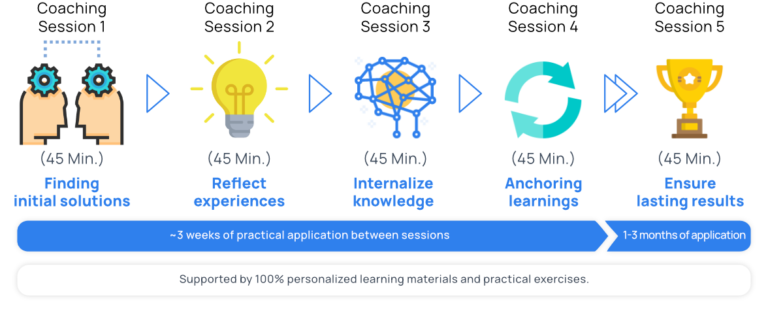
The Sparrks leadership coaching framework consists of four to five compact, 45-minute coaching sessions. Between sessions, coachees actively apply their learnings in their daily work—supported by targeted reflection and practice phases. This practical format maximizes impact with minimal time investment, making high-impact leadership coaching accessible to talents at all levels—from top management to operational leadership.
The results are immediate and (because they are developed and encoded throughout the process) penetrate the behavior of coachees. In the words of a business coach, it is like having a top coach dedicated to your company on clear deliverables achievable in sprints. Immediate results have turned Sparrks into one of the most successful leadership coaching methods.
CLEAR
CLEAR, developed by Peter Hawkins in 1985, is a widely used executive coaching method that facilitates transformational change. This model involves multiple sessions and focuses on helping clients achieve their desired outcomes for themselves and their organization.
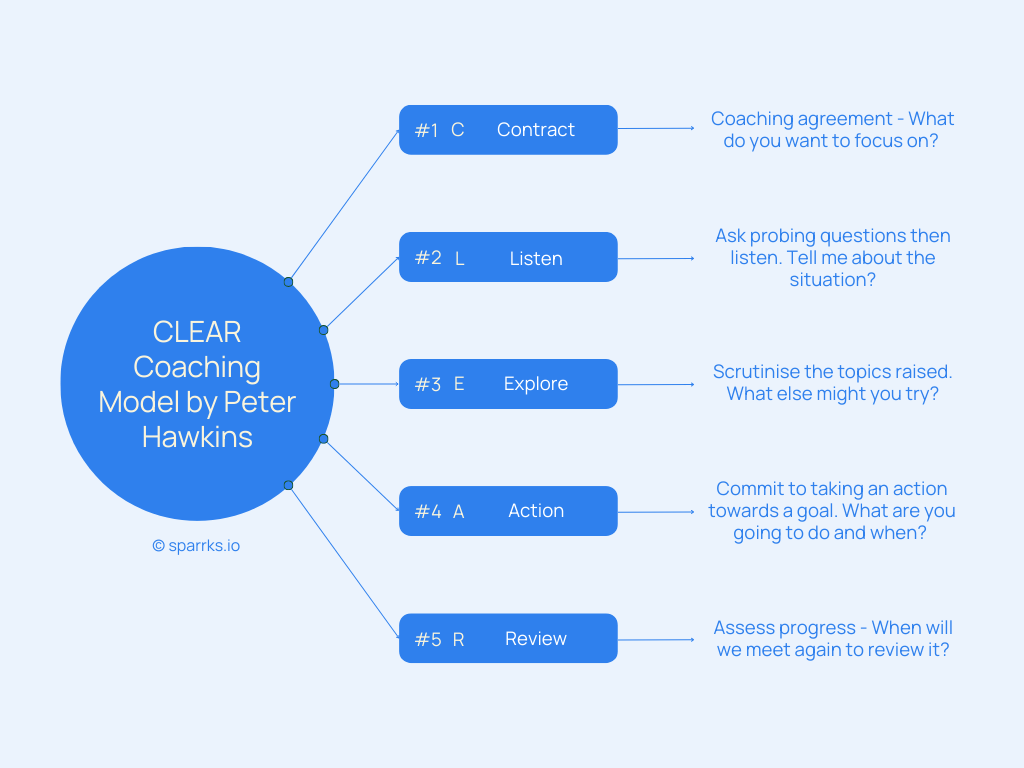
Coaches should start by listening actively to their client's thoughts and feelings. Then, coaches should ask catalytic questions designed to foster an understanding of a specific situation. Through context exploring, clients can build an emotional connection with the changes required.
Individuals and organizations alike act towards achieving their goals by internalizing new perspectives once they establish clarity on what needs changing. They ensure accountability remains high throughout all stages involved by reviewing progress made and making real headway together over time without losing sight of where they began their journey initially. CLEAR coaching provides everything needed when looking into transformative leadership development programs today.
Action Centred Leadership
The Action Centred Leadership method or model by John Adair is a versatile approach that applies to most leadership types. Such a model is particularly relevant to CEOs, medium- to high-level managers, and team leaders. This method emphasizes the importance of three key areas where leaders should focus their efforts: task achievement, team formation/upkeep, and individual development. While each aspect requires attention from the leader at all times, certain circumstances may require more emphasis on one over another.
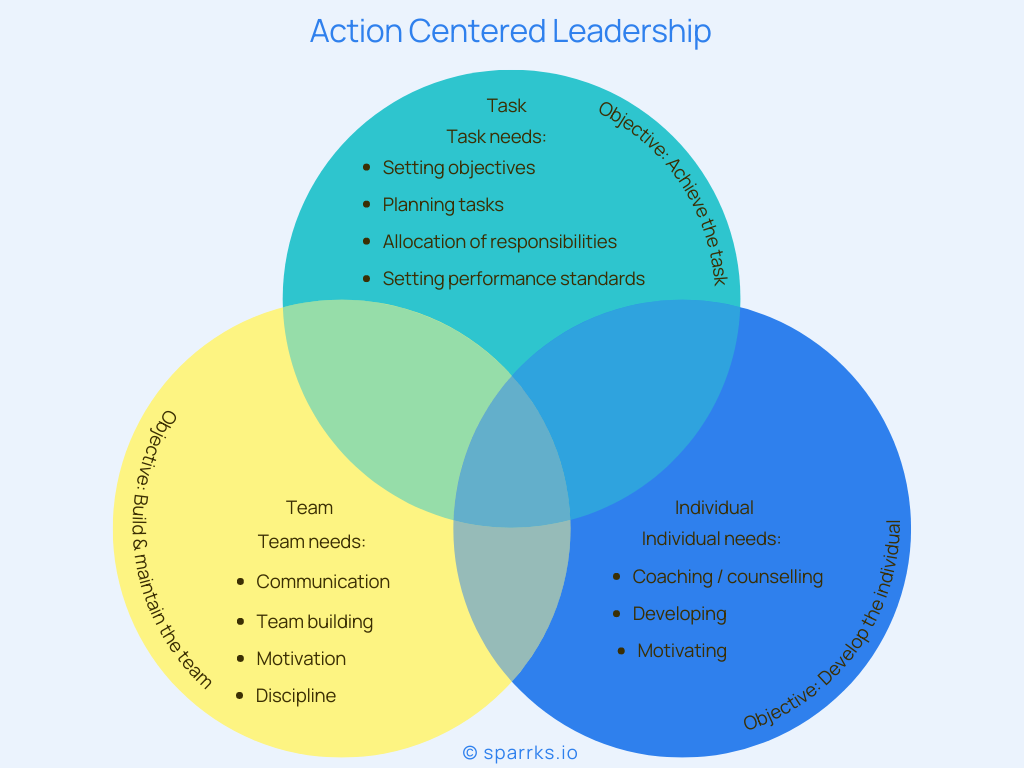
Task achievement involves identifying goals with your client as a leader and creating strategies to achieve them while allocating resources effectively. Team formation/upkeep stresses team unification through setting standards, monitoring conflict resolution techniques, encouraging good communication skills, and giving constructive criticism. Finally, individual development deals with positively impacting single units within a group or team so they are motivated towards achieving their objectives.
Systemic coaching
The famous representatives of this leadership coaching method have worked at the Humboldt University zu Berlin. To them, systemic coaching means supporting and accompanying individuals, teams, and organizations within discrete or organizational change processes based on systemic thinking and interventions. The reasons for a systemic coaching intervention can be either a problematic situation or a development project. Such a method is rooted in system theory, constructivism, humanistic psychology, and Gestalt therapy.
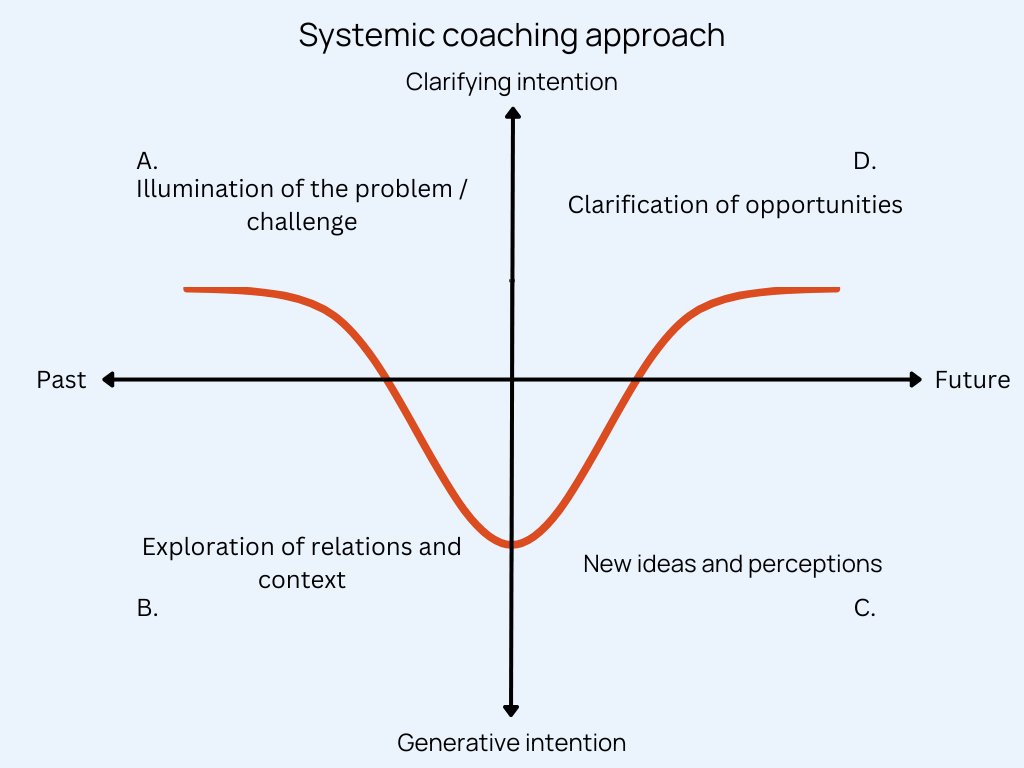
Systemic coaching triggers self-improvement by encouraging emotional and cognitive self-management, discovering individual aspirations and motivations, and devising effective plans to bridge personal experiences with professional demands. It is a powerful tool for those seeking guidance in aligning their behavior with career objectives while fostering autonomy through introspection.
Victim vs. player method
The world-renowned executive coach Fred Kofman is the father of the victim vs. player method. Kofman described this powerful technique in his book "Conscious Business". Since then, coaches worldwide included victim vs. player in their coaching sessions. The approach is particularly relevant when facing challenges, no matter their magnitude.
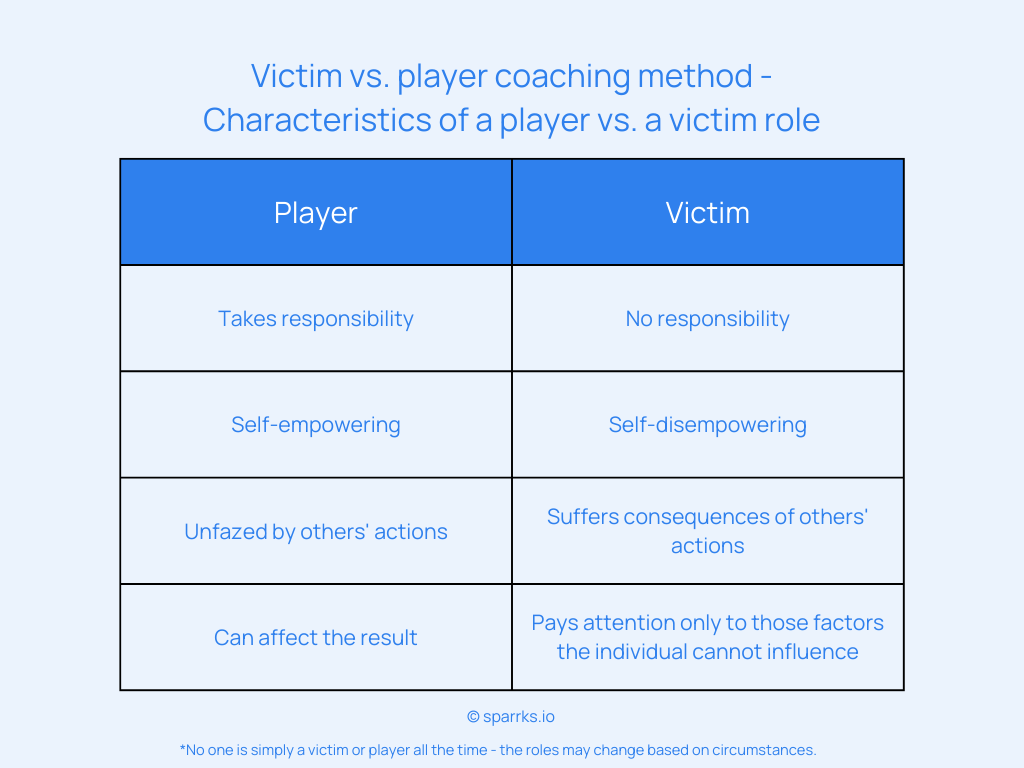
In victim vs. player, there are two vectors in any situation - those factors under your control and those outside it. When something happens to you, you can either adopt a victim mentality or choose to take responsibility for how your actions may have contributed to the outcome.
The victim phase absolves one from blame but also renders them powerless over their circumstances. They are innocent yet incompetent bystanders who cannot change anything about what happened. An example victim statement goes as follows: I was late to work because of traffic..
In contrast, in the player phase or mindset, individuals acknowledge their role in creating an unfavorable situation. However, admission of guilt empowers them with power over future outcomes through actionable steps toward improvement. An example player statement goes as follows: I was late to work because I did not get ready on time..
Leipzig Leadership method
The Leipzig Leadership method is a comprehensive approach that empowers leaders to act independently, cultivate positive attitudes, and achieve success while maintaining good health in today's intricate world. The model revolves around the individual who exhibits innovative and entrepreneurial responsibility. It caters explicitly to organizations of varying sizes, types, and industries with global significance.
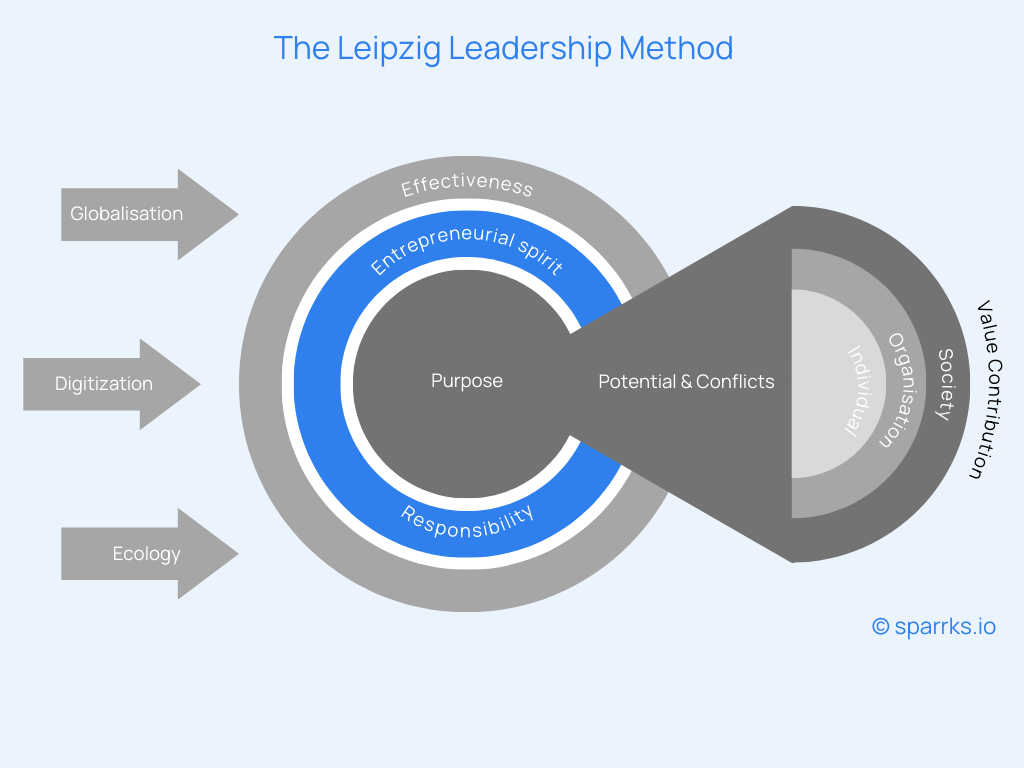
Coaches trained in the Leipzig Leadership methodology prioritize three fundamental principles: Firstly, it is crucial for individuals to pursue their true passion - at least over an extended period; Secondly, conflicts can turn into opportunities for constructive change & creative solutions; And thirdly, exchanging experiences & valid concepts forms the bedrock of coaching.
Leadership coaching methods - Conclusion
In conclusion, effective leadership coaching methods are crucial for any company that wants to thrive in today's competitive business world. Companies can improve employee engagement, productivity, communication, and profitability by implementing the most relevant coaching methodology. The seven methods analyzed in this article are highly effective, and it's up to HR representatives and decision-makers to choose the ones that best suit their organization's needs. Investing in a solution that deploys a highly-effective but applicable leadership coaching method is an investment in your company's sustainable success.

FAQ: Effective leadership coaching methods
What is a coaching methodology?
A coaching methodology or method is a set of practices, strategies, and techniques to help coachees learn new skills and achieve goals. Effective coaching methods all focus on developing trust between a coach and coachee, fostering motivation toward learning and growth, and open communication.
What is a team coach vs. an individual coach?
No matter the framework, an individual coach helps individuals identify problems and find solutions through one-on-one coaching sessions. A team coach conducts group sessions where multiple team members try collectively to find the right way to navigate issues.
What is a coaching framework?
A coaching framework comprises predetermined benchmarks created to steer a succession of coaching discussions. Such an approach aids in keeping both coaches and coachees aligned, gauging progress, and guaranteeing that the client attains the intended goal. You can think of a coaching framework as a coaching methodology plus how that method is packaged and delivered.




